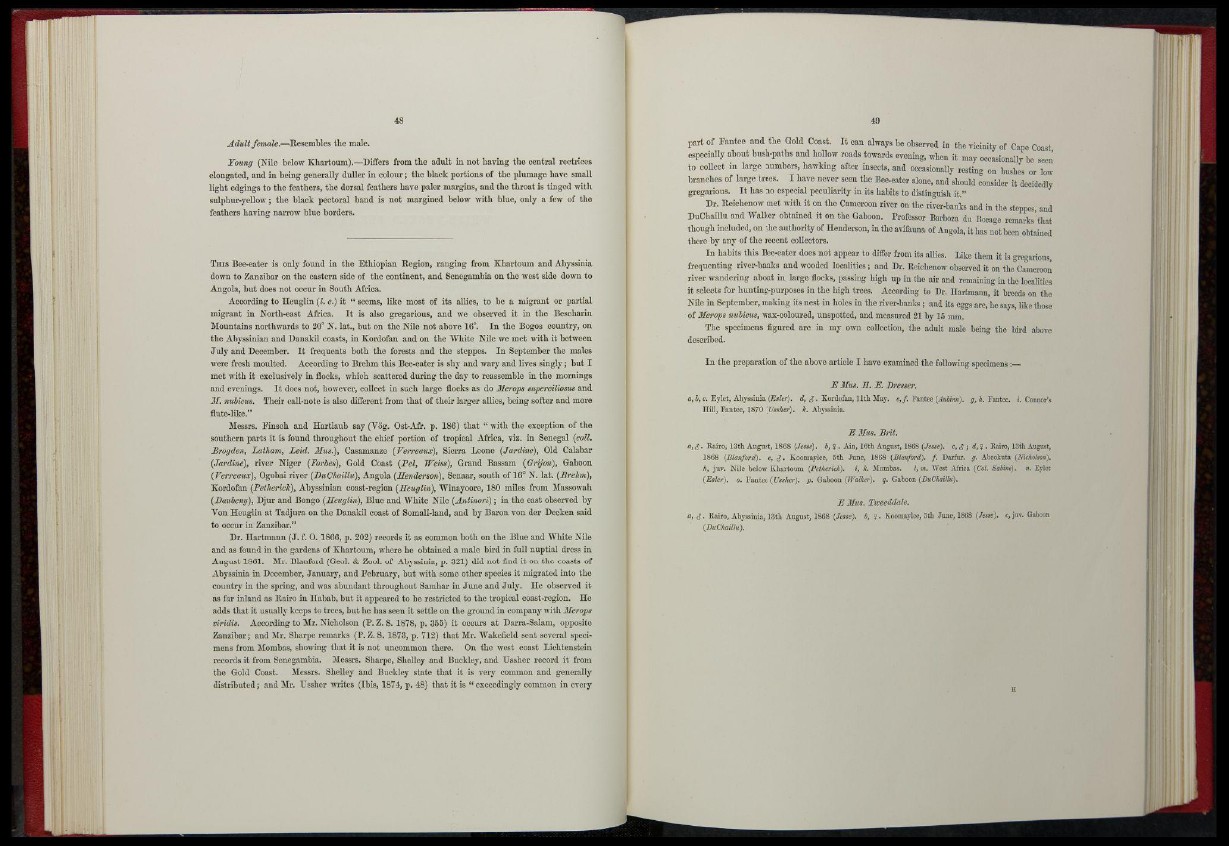
Adult female.—.Resembles tbe male.
Young (Nile below Khartoum). —Differs from the adult in not having the central rectrices
elongated, and in being generally duller in colour; the black portions of the plumage have small
light edgings to the feathers, the dorsal feathers have paler margins, and the throat is tinged with
sulphur-yellow; the black pectoral band is not margined below with blue, only a few of the
feathers having narrow blue borders.
THIS Bee-eater is only found in tbe Ethiopian Region, ranging from Khartoum and Abyssinia
down to Zanzibar on the eastern side of the continent, and Senegambia on the west side down to
Angola, but does not occur in South Africa.
According to Heuglin (I. c.) it " seems, like most of its aUies, to be a migrant or partial
migrant in North-east Africa. It is also gregarious, and we observed it in the Bescharin
Mountains northwards to 20° N. lat., but on the Nile not above 16°. In the Bogos country, on
tbe Abyssinian and Danakil coasts, in Kordofan and on the White Nile we met with it between
July and December. It frequents both the forests and t he steppes. In September tbe males
were fresh moulted. According to Brehm this Bee-eater is shy and wary and lives singly; but I
met with it exclusively in flocks, which scattered during the day to reassemble in the mornings
and evenings. It does not, however, collect in such large flocks as do Merops superciliosus and
JT. nuhlcus. Their caU-note is also different from that of their larger allies, being softer and more
flute-like.''
Messrs. Finsch and Hartlaub say (Vog. Ost-Afr. p. 186) that " with the exception of the
southern parts it is found throughout the chief portion of tropical Africa, viz. in Senegal (coll.
Jhogden, Latham, Leid. Mus.), Casamanze (Verreaux), Sierra Leone (Jardine), Old Calabar
(Jardine), river Niger (Forbes), Gold Coast (Pel, Weiss), Grand Bassam (Grijon), Gaboon
(Verreaux), Ogobai river (DuChaillu), Angola (Henderson), Senaar, south of 16° N. lat. (Brehm),
Kordofan (Petherick), Abyssinian coast-region (Heuglin), Winayoore, 180 miles from Massowrah
(Dauheny), Djur and Bongo (Heuglin), Blue and White Nile (Antinori); in the east observed by
Von Heuglin at Tadjura on the Danakil coast of Somali-land, and by Baron von der Decken said
to occur in Zanzibar."
Dr. Hartmann (J. f. 0 . 1866, p. 202) records it as common both on the Blue and White Nile
and as found in the gardens of Khartoum, where he obtained a male bird in full nuptial dress in
August 1861. Mr. Blanford (Geol. & Zool. of Abyssinia, p. 321) did not find it on the coasts of
Abyssinia in December, January, and February, but with some other species it migrated into the
country in the spring, and was abundant throughout Samhar in June and July. He observed it
as far inland as Bairo in Habab, but it appeared to be restricted to the tropical coast-region. He
adds that it usually keeps to trees, but he has seen it settle on the ground in company with Merops
viridis. According to Mr. Nicholson (P. Z. S. 1878, p. 355) it occurs at Darra-Salam, opposite
Zanzibar; and Mr. Sbarpe remarks (P. Z. S. 1873, p. 712) that Mr. Wakefield sent several specimens
from Mombas, showing that it is not uncommon there. On the west coast Lichtenstein
records it from Senegambia. Messrs. Sbarpe, SheUey and Buckley, and Ussher record it from
the Gold Coast. Messrs. Shelley and Buckley state that it is very common and generally
distributed; and Mr. Ussher writes (Ibis, 1874, p . 48) that it is "exceedingly common in every
part of Eantcc and t he Gold Coast. It can always be observed in the vicinity of Cape Coast,
especially about bush-paths and hollow roads towards evening, when it may occasionally be seen
to collect in large numbers, hawking after insects, and occasionally resting on bushes or low
branches of large trees. I have never seen the Bee-eater alone, and should consider it decidedly
gregarious. I t has no especial peculiarity in its habits to distinguish it."
Dr. Reichenow met with it on the Cameroon river on the river-banks and in the steppes, and
DuChaillu and Walker obtained it on the Gaboon. Professor Barboza du Socage remarks that
though included, on the authority of Henderson, in the avifauna of Angola, it has not been obtained
there by any of the recent coUectors.
In habits this Bee-cater does not appear to differ from its allies. Like them it is gregarious,
frequenting river-banks and wooded localities ; and Dr. Reichenow observed it on the Cameroon
river wandering about in large flocks, passing high up in the air and remaining iu the localities
it selects for hunting-purposes in the high trees. According to Dr. nartmann, it breeds on tbe
Nile in September, making its nest in holes in the river-banks ; and its eggs are, he says, like those
of Merops nulncus, wax-coloured, unspotted, and measured 21 by 15 mm.
The specimens figured are in my own collection, the adult male being the bird above
described.
I n the preparation of the above article I have examined the following specimens :—
E Mus. H. E. Dresser.
a,b,c. Eylct, Abyssinia (Esler). d, £. Kordofan, 11th May. e,f. Eantcc (AuUnn). g,h. Fantcc. i, Connor's
Hill, Fantcc, 1870 (Ussher). k. Abyssinia.
EMas. Brit.
a,<J. Rairo, 13th August, 18G8 (Jesse), b, ? . Ain, 16th August, 1868 (Jesse), c, <J ; d, ? . Rairo, 13th August,
1868 (Blanford). e, Koomaylcc, 5th June, 1868 (Blanford). f. Darfur. g. Abeokuta (Mc/whon).
h, juv. Nile below Khartoum (Petherick). i, k. Mombas. l,m. West Africa (Col. Sabine), n. Eylct
(Esler). o. Fantce (Ussher). p. Gaboon (Walker), q. Gaboon (DuChaillu).
E Mus. Tweeddale.
a, «J. Rairo, Abywbia, 13th August, 1868 (Jesse), b, ? . Koomaylcc, 5th June, 1868 (Jesse), e, juv. Gaboon
(DuChaillu).
it